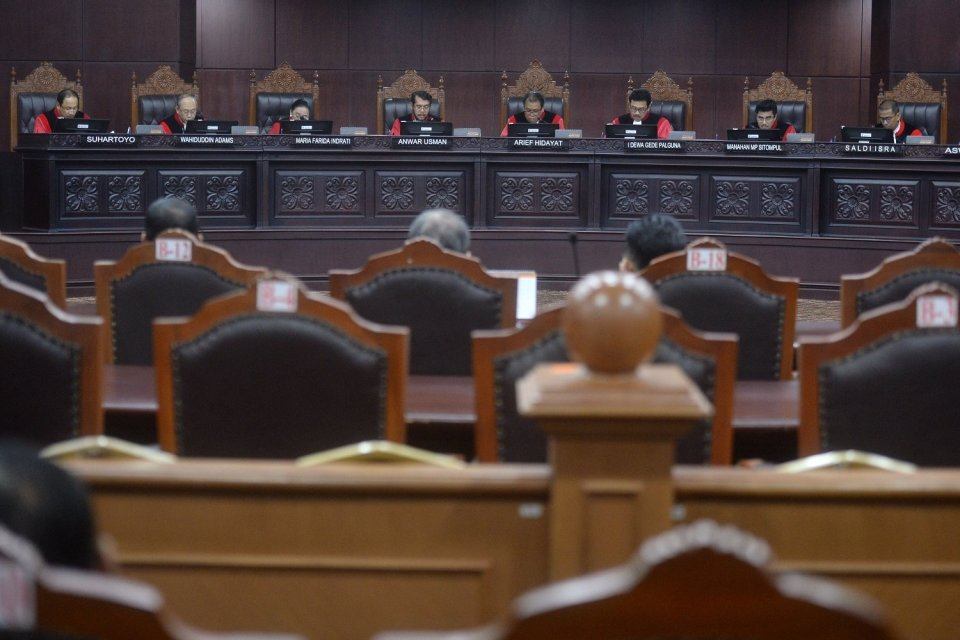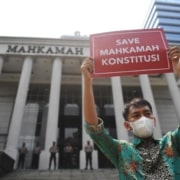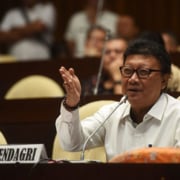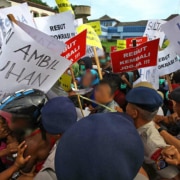
The Constitutional Court’s nine judges heard about 100 electoral disputes over the course of a single week. Photo by Akbar Nugroho Gumay for Antara.
On 9 August, the Constitutional Court resolved the final dispute over the 2019 election results. Although the Court has ordered recounts in some areas, we can now say that Indonesia’s first ever “simultaneous” elections – where national and regional legislators and the president and vice president pair were elected on the same day – are almost over. It is now possible to assess how Indonesia’s experiment with simultaneous elections fared and to consider whether Indonesia should, or could, return to separate legislative and presidential elections in 2024.
The election was a massive logistical exercise. Even when they were held separately, Indonesian elections were already among the world’s most complicated and difficult. Some have claimed that having the elections simultaneously led to many errors in counting and recapitulation and to problems with general election administration, undermining the legitimacy of the elections. While there were undoubtedly mistakes, administrative problems, and significant corruption, there is little to suggest that the 2019 election was any worse than previous elections.
The Constitutional Court decided hundreds of disputes about the results of the 2019 elections, as it has done for previous elections. Prabowo Subianto and Sandiaga Uno lost their challenge to the 2019 presidential election results, primarily because they did not provide sufficient evidence to substantiate their claim that “structured, systematic and massive” violations took place before, during and after the elections, causing them to lose the election.
The Court also decided more than 200 legislative election disputes, with about 100 going to a full hearing. The Court’s nine judges divided into three panels to hear evidence concerning these 100 cases over the course of a single week (23-30 July), with proceedings often going late into the night. This means that the Court could have allocated only a few hours to hear each case.
It seems impossible to properly examine the detail of the usually-complex arguments and evidence in such a short time. To meet its deadlines, the Court also barred the parties in each dispute from calling more than three witnesses, saying that documentary evidence was more important in electoral disputes anyway. While documentary evidence might be central to proving vote counting errors, witness testimony is surely critical to proving many types of fraud. And surely more than three witnesses would be needed to prove that a violation was “massive”. Yet for all these shortcomings, the Court’s resolution of these disputes appeared largely orderly and did not spark any violent responses from the public.
Perhaps the main negative consequence of simultaneous elections was the death of well over 600 officials, primarily from exhaustion. These officials set up polling stations, oversaw the voting and then counted the votes. The 2017 General Elections Law requires that votes be counted on election day. So, after a long day, many worked late into the night and into the early hours of the morning to check and cross check their counts.
It was anticipated that running these elections simultaneously would increase efficiency and reduce costs. But it did not. According to one report, the 2019 simultaneous elections cost 60 per cent more to run than the 2014 elections.
From a democratic perspective, perhaps the biggest problem with simultaneous elections was that they interfered with the presidential nomination process. Ever since 2004, when direct presidential elections began in Indonesia, electoral statutes have required that parties or coalitions meet a “presidential nomination threshold” to nominate their preferred candidate pairs. For the past three elections, this has been 20 per cent of national legislative seats or 25 per cent of the total vote.
Before 2019, when presidential elections were held three months after legislative elections, this was not problematic because parties nominated their preferred presidential candidates after they knew how many seats and votes they had. But with simultaneous elections, presidential nominations needed to happen before election day. This caused problems because parties could not know how many votes or seats they would win in the legislative election before nominating their presidential candidates.
The solution, contained in the 2017 General Elections Law, was to base the nomination threshold on the results of the 2014 legislative elections. In other words, political parties serving in the 2014-2019 legislature got to nominate presidential candidates for the 2019-2024 presidential term, regardless of how many seats in the legislature or votes they might obtain in the 2019 legislative elections.
This undermines the main rationale for the presidential nomination system: because parties must work with the presidential pair that are eventually elected, they get to nominate their preferred pair. This rationale falls away if the legislature that nominates a president is not the same legislature that then has to work with that president.
This flaw did not appear to cause fundamental problems in the 2019 elections, because the number of votes the top three parties obtained was within a few million votes of their 2014 results. But if one of the parties loses a significant proportion of their vote share because of scandal or poor performance, as Susilo Bambang Yudhoyono’s Democratic Party did in the 2014 elections, then allowing them to have a real say in presidential nominations for future elections seems inappropriate.
The deaths of polling officials have led some to suggest that Indonesia should revert to separate elections. Ironically, Constitutional Court judges have been among those suggesting this, even though simultaneous elections were only introduced because of a Constitutional Court decision handed down in 2014. Even more ironic is that, before they joined the Court, two of these judges, Anwar Usman and Saldi Isra, were involved in the Civil Society Coalition for Simultaneous Elections which brought the case that resulted in the Court’s decision to introduce simultaneous elections in the first place.
But there are some constitutional barriers to returning to separate elections. Article 22E of the Constitution states that “general elections” include both presidential and legislative elections; that general elections are to be held once every five years; and that parties are to nominate presidential candidates before the general elections.
The Constitutional Court was, therefore, probably right to declare the three-month-break model unconstitutional. Alternatives exist, such as holding the elections over a few consecutive days, or introducing e-voting. They are worth considering, because going back to the old system might require amendment to the Constitution – and that is unlikely to happen any time soon.
This article is part of a series of posts by presenters at “The 2019 Indonesian Elections: Electoral Accountability and Democratic Quality” workshop, held at the University of Melbourne on 6-7 August.






 https://theconversation.com/a-twist-in-indonesias-presidential-election-does-not-bode-well-for-the-countrys-fragile-democracy-216007
https://theconversation.com/a-twist-in-indonesias-presidential-election-does-not-bode-well-for-the-countrys-fragile-democracy-216007 


